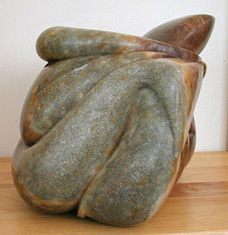If You Only Knew
A lot of my recurring themes come back in this commissioned piece. Body and flower forms intertwine so that you can’t tell where one starts and the other ends, nor what shape they are if they let go of each other. The idea of a reassuring hug and the element of touch are very important. When this sculpture was finished, I wrote these notes for the buyer:
- The sculpture can mean whatever you wish it to mean. It has a life of its own now. When I was working on it, I was thinking about emotion and how it is internalized. I was thinking about swirling emotions and how the outside might not totally reflect the inside – from the “back” you can not see the swirling inside of the “front”. I hope some of that idea is reflected in it. Thus the name “If You Only Knew” because you can not always know what someone else is feeling. The outside might not even let you in on it.
- The stone for “If You Only Knew” was purchased from: Montoya Sculpture Supply in Florida. The stoned weighed 95 lbs to start with. There was a fancy name for the stone in the catalogue to lure you but it is simply “alabaster” from Mexico.
- Occasionally when in progress I would need to wash down the stone and when I did it was so fragrant. I even had people“sniff” it for me! We identified it as a strong clay smell – it was very earthy and a wonderful surprise.
- The green part of the stone has a special feature. I think of this area as “right of front”. My geologist friend got all excited when she saw it because she said it is “oolitic” – (consisting of spherical or sub-spherical particles of calcite-coated grains of sand.) . This means that it was on its way to becoming limestone but just did not get there yet. This stone was definitely not “done” becoming what it was going to be when conditions changed and development stopped.
- When I started the final sanding, I used water with the sandpaper. The “left of front” portion of the stone eroded away slightly. You will see that the “lip line” of the curve has a small bit out of it now but it was a perfect curve before using water. I hope you think it is interesting because I left the flaw to show this strange feature of the stone. It was hardened everywhere but there was still a soft streak in it. This weakness was a surprise.
- Also in the stone are some fine lines that look like cracks or white lines. These are fissures or faults in the stone. They go all the way through the sculpture and are not unusual in alabaster. When working on the stone it was important to not hammer the chisel in these spots because the stone could have split there.
- The sculpture took two years from start to finish because I worked on it only in the cold weather while I was finishing the big limestone sculpture The Understanding. Once that was shipped off to Syracuse, I worked “If You Only Knew” from mid July – mid September 2000 for 4-6 hours/day. During the winter months and those last few months, it was heaven to really concentrate on this stone.
- To carve the stone I first used the pneumatic hammer and chisel to rough it out, then hand chisel and hammer. Mostly though, I used rasps to shape it. The size ranged from 14 inch/typical half round wood rasp to tiny 1/8 inch rasps to make those lines perfect and beautiful. Various sandpapers helped in shaping it; I especially like sandpaper used by auto body repair shops. 60-80-100 grit sandpapers are used early on. To finalize the shape 100 grit sandpaper is used everywhere, getting the shape exactly how I wanted it. Sometimes I had to back track to rasps and chisels if a shape was not working properly. 100 grit sandpaper takes the longest because it is a commitment! Each sanding has to be thorough. You can’t skip or do a sloppy job or the stone will not live up to its potential luster. Each sanding took 3-4 hours. 100 grit sandpaper probably took 15 hours. After 100 were 120, 150, 220, 240 with water and the rest are with water – 320, 440, 600 and for fun I even used 1500 grit sandpaper! I had it around and thought I’d use it. My friend Karen, also a sculptor, commented, “may as well use a piece of typing paper!”
| Completed: | 2000 |
| Dimensions: | 10″ x 12″ x 9″ |
| Materials: | Mexican Alabaster |
| Collection: | Brad and Sherry Eichhorst Hawaii and Minnesota |




